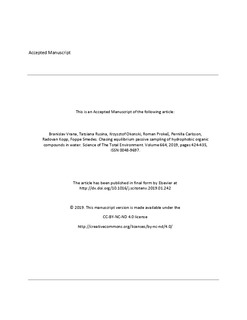| dc.contributor.author | Vrana, Branislav | |
| dc.contributor.author | Rusina, Tatsiana P. | |
| dc.contributor.author | Okonski, Krzysztof | |
| dc.contributor.author | Prokeš, Roman | |
| dc.contributor.author | Carlsson, Pernilla Marianne | |
| dc.contributor.author | Kopp, Radovan | |
| dc.contributor.author | Smedes, Foppe | |
| dc.date.accessioned | 2019-11-18T12:06:58Z | |
| dc.date.available | 2019-11-18T12:06:58Z | |
| dc.date.created | 2019-06-14T13:15:37Z | |
| dc.date.issued | 2019 | |
| dc.identifier.citation | Science of the Total Environment. 2019, 664, 424-435. | nb_NO |
| dc.identifier.issn | 0048-9697 | |
| dc.identifier.uri | http://hdl.handle.net/11250/2629023 | |
| dc.description | Embargo until 24 January 2021 | nb_NO |
| dc.description.abstract | We investigated a combination of approaches to extend the attainment of partition equilibria between silicone passive samplers (samplers) and surface or treated waste water towards more hydrophobic organic compounds (HOC). The aim was to identify the HOC hydrophobicity range for which silicone sampler equilibration in water is feasible within a reasonable sampler deployment period. Equilibrium partitioning of HOC between sampler and water is desirable for a simpler application as a “chemometer”, aiming to compare chemical activity gradients across environmental media (e.g. water, sediment, biota). The tested approaches included a) long sampler exposure periods and high water flow to maximize mass transfer from water to sampler; b) the use of samplers with reduced sheet thicknesses; and c) pre-equilibration of samplers with local bottom sediment, followed by their exposure in surface water at the same sampling site. These approaches were tested at three sites including a fish pond with a low level of pollution, a river impacted by an urban agglomeration and an effluent of municipal wastewater treatment plant. Tested compounds included polychlorinated biphenyls (PCB), polycyclic aromatic hydrocarbons (PAH), DDT, its metabolites and their isomers, hexachlorobenzene (HCB) and polybrominated diphenyl ethers (PBDE). The study shows that samplers with a surface area of 400–800 cm2 consisting of thin (100–500 μm) silicone sheets exposed at sampling rates of 10–40 L d−1 for a time period of up to four months reach partition equilibrium with water for compounds with log Kow ≤ 5.5. Nevertheless, for compounds beyond this limit it is challenging, within a reasonable time period, to reach equilibrium between sampler and water in an open system where water boundary layer resistance controls the mass transfer. For more hydrophobic HOC (log Kow > 6), the kinetic method using performance reference compounds is recommended instead. | nb_NO |
| dc.language.iso | eng | nb_NO |
| dc.publisher | Elsevier | nb_NO |
| dc.rights | Attribution-NonCommercial-NoDerivatives 4.0 Internasjonal | * |
| dc.rights.uri | http://creativecommons.org/licenses/by-nc-nd/4.0/deed.no | * |
| dc.title | Chasing equilibrium passive sampling of hydrophobic organic compounds in water | nb_NO |
| dc.type | Journal article | nb_NO |
| dc.type | Peer reviewed | nb_NO |
| dc.description.version | acceptedVersion | nb_NO |
| dc.source.pagenumber | 424-435 | nb_NO |
| dc.source.volume | 664 | nb_NO |
| dc.source.journal | Science of the Total Environment | nb_NO |
| dc.identifier.doi | 10.1016/j.scitotenv.2019.01.242 | |
| dc.identifier.cristin | 1704990 | |
| cristin.unitcode | 7464,30,21,0 | |
| cristin.unitname | Miljøkjemi | |
| cristin.ispublished | true | |
| cristin.fulltext | postprint | |
| cristin.qualitycode | 2 | |

